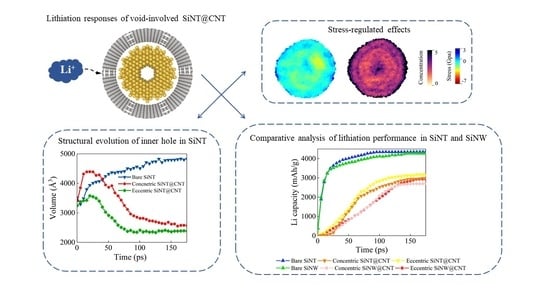Molecular Understanding of Electrochemical–Mechanical Responses in Carbon-Coated Silicon Nanotubes during Lithiation
Abstract
1. Introduction
2. Simulation Methods
3. Results and Discussion
3.1. Morphological Evolution and Lithiation Performance of Silicon Nanotubes
3.2. Structural Evolution of Inner Hole
3.3. Stress-Regulated Effects during Lithiation
4. Conclusions
Author Contributions
Funding
Data Availability Statement
Conflicts of Interest
References
- Li, M.; Lu, J.; Chen, Z.; Amine, K. 30 Years of Lithium-Ion Batteries. Adv. Mater. 2018, 30, 1–24. [Google Scholar] [CrossRef]
- Liu, X.H.; Wang, J.W.; Huang, S.; Fan, F.; Huang, X.; Liu, Y.; Krylyuk, S.; Yoo, J.; Dayeh, S.A.; Davydov, A.V.; et al. In situ atomic-scale imaging of electrochemical lithiation in silicon. Nat. Nanotechnol. 2012, 7, 749–756. [Google Scholar] [CrossRef]
- Zuo, X.; Zhu, J.; Müller-Buschbaum, P.; Cheng, Y.J. Silicon based lithium-ion battery anodes: A chronicle perspective review. Nano Energy 2017, 31, 113–143. [Google Scholar] [CrossRef]
- Liang, H.; Zhang, X.; Yang, L.; Wu, Y.; Chen, H.; Song, W.; Fang, D. Electrochemomechanical coupled behaviors of deformation and failure in electrode materials for lithium-ion batteries. Sci. China Technol. Sci. 2019, 62, 1277–1296. [Google Scholar] [CrossRef]
- Ko, M.; Chae, S.; Cho, J. Challenges in Accommodating Volume Change of Si Anodes for Li-Ion Batteries. ChemElectroChem 2015, 2, 1645–1651. [Google Scholar] [CrossRef]
- Su, X.; Wu, Q.; Li, J.; Xiao, X.; Lott, A.; Lu, W.; Sheldon, B.W.; Wu, J. Silicon-Based nanomaterials for lithium-ion batteries: A review. Adv. Energy Mater. 2014, 4, 1–23. [Google Scholar] [CrossRef]
- Chakrapani, V.; Rusli, F.; Filler, M.A.; Kohl, P.A. Silicon nanowire anode: Improved battery life with capacity-limited cycling. J. Power Sources 2012, 205, 433–438. [Google Scholar] [CrossRef]
- Yoo, J.K.; Kim, J.; Jung, Y.S.; Kang, K. Scalable fabrication of silicon nanotubes and their application to energy storage. Adv. Mater. 2012, 24, 5452–5456. [Google Scholar] [CrossRef] [PubMed]
- Liu, N.; Wu, H.; McDowell, M.T.; Yao, Y.; Wang, C.; Cui, Y. A yolk-shell design for stabilized and scalable Li-ion battery alloy anodes. Nano Lett. 2012, 12, 3315–3321. [Google Scholar] [CrossRef] [PubMed]
- Xiao, X.; Zhou, W.; Kim, Y.; Ryu, I.; Gu, M.; Wang, C.; Liu, G.; Liu, Z.; Gao, H. Regulated breathing effect of silicon negative electrode for dramatically enhanced performance of Li-ion battery. Adv. Funct. Mater. 2015, 25, 1426–1433. [Google Scholar] [CrossRef]
- Gattu, B.; Epur, R.; Jampani, P.H.; Kuruba, R.; Datta, M.K.; Kumta, P.N. Silicon-Carbon Core-Shell Hollow Nanotubular Configuration High-Performance Lithium-Ion Anodes. J. Phys. Chem. C 2017, 121, 9662–9671. [Google Scholar] [CrossRef]
- Liu, R.; Shen, C.; Dong, Y.; Qin, J.; Wang, Q.; Iocozzia, J.; Zhao, S.; Yuan, K.; Han, C.; Li, B.; et al. Sandwich-like CNTs/Si/C nanotubes as high performance anode materials for lithium-ion batteries. J. Mater. Chem. A 2018, 6, 14797–14804. [Google Scholar] [CrossRef]
- Chan, C.K.; Peng, H.; Liu, G.; McIlwrath, K.; Zhang, X.F.; Huggins, R.A.; Cui, Y. High-performance lithium battery anodes using silicon nanowires. Nat. Nanotechnol. 2008, 3, 31–35. [Google Scholar] [CrossRef]
- Zhou, X.; Yin, Y.X.; Wan, L.J.; Guo, Y.G. Self-assembled nanocomposite of silicon nanoparticles encapsulated in graphene through electrostatic attraction for lithium-ion batteries. Adv. Energy Mater. 2012, 2, 1086–1090. [Google Scholar] [CrossRef]
- Suresh, S.; Wu, Z.P.; Bartolucci, S.F.; Basu, S.; Mukherjee, R.; Gupta, T.; Hundekar, P.; Shi, Y.; Lu, T.M.; Koratkar, N. Protecting Silicon Film Anodes in Lithium-Ion Batteries Using an Atomically Thin Graphene Drape. ACS Nano 2017, 11, 5051–5061. [Google Scholar] [CrossRef]
- Ding, B.; Li, X.; Zhang, X.; Wu, H.; Xu, Z.; Gao, H. Brittle versus ductile fracture mechanism transition in amorphous lithiated silicon: From intrinsic nanoscale cavitation to shear banding. Nano Energy 2015, 18, 89–96. [Google Scholar] [CrossRef]
- Fan, F.; Yang, H.; Zeng, Z. An atomistic perspective on lithiation-induced stress in silicon nanopillars. Scr. Mater. 2018, 152, 74–78. [Google Scholar] [CrossRef]
- Basu, S.; Koratkar, N.; Shi, Y. Structural transformation and embrittlement during lithiation and delithiation cycles in an amorphous silicon electrode. Acta Mater. 2019, 175, 11–20. [Google Scholar] [CrossRef]
- Shi, F.; Song, Z.; Ross, P.N.; Somorjai, G.A.; Ritchie, R.O.; Komvopoulos, K. Failure mechanisms of single-crystal silicon electrodes in lithium-ion batteries. Nat. Commun. 2016, 7, 11886. [Google Scholar] [CrossRef]
- Wang, C.; Wen, J.; Luo, F.; Quan, B.; Li, H.; Wei, Y.; Gu, C.; Li, J. Anisotropic expansion and size-dependent fracture of silicon nanotubes during lithiation. J. Mater. Chem. A 2019, 7, 15113–15122. [Google Scholar] [CrossRef]
- Feng, C.; Shi, T.; Li, J.; Cheng, S.; Liao, G.; Tang, Z. Effects of pre-existing interfacial defects on the structural evolution of alumina coated Si electrode during delithiation. Appl. Surf. Sci. 2020, 520, 146366. [Google Scholar] [CrossRef]
- Jung, H.; Lee, M.; Yeo, B.C.; Lee, K.-R.; Han, S.S. Atomistic Observation of the Lithiation and Delithiation Behaviors of Silicon Nanowires Using Reactive Molecular Dynamics Simulations. J. Phys. Chem. C 2015, 119, 3447–3455. [Google Scholar] [CrossRef]
- Kim, K.J.; Qi, Y. Vacancies in Si Can Improve the Concentration-Dependent Lithiation Rate: Molecular Dynamics Studies of Lithiation Dynamics of Si Electrodes. J. Phys. Chem. C 2015, 119, 24265–24275. [Google Scholar] [CrossRef]
- Kim, S.-P.; Datta, D.; Shenoy, V.B. Atomistic Mechanisms of Phase Boundary Evolution during Initial Lithiation of Crystalline Silicon. J. Phys. Chem. C 2014, 118, 17247–17253. [Google Scholar] [CrossRef]
- Ding, B.; Wu, H.; Xu, Z.; Li, X.; Gao, H. Stress effects on lithiation in silicon. Nano Energy 2017, 38, 486–493. [Google Scholar] [CrossRef]
- Ostadhossein, A.; Cubuk, E.D.; Tritsaris, G.A.; Kaxiras, E.; Zhang, S.; Van Duin, A.C.T. Stress effects on the initial lithiation of crystalline silicon nanowires: Reactive molecular dynamics simulations using ReaxFF. Phys. Chem. Chem. Phys. 2015, 17, 3832–3840. [Google Scholar] [CrossRef] [PubMed]
- Wu, H.; Chan, G.; Choi, J.W.; Ryu, I.; Yao, Y.; McDowell, M.T.; Lee, S.W.; Jackson, A.; Yang, Y.; Hu, L.; et al. Stable cycling of double-walled silicon nanotube battery anodes through solid–electrolyte interphase control. Nat. Nanotechnol. 2012, 7, 310–315. [Google Scholar] [CrossRef]
- Hertzberg, B.; Alexeev, A.; Yushin, G. Deformations in Si−Li Anodes Upon Electrochemical Alloying in Nano-Confined Space. J. Am. Chem. Soc. 2010, 132, 8548–8549. [Google Scholar] [CrossRef] [PubMed]
- Ge, M.; Rong, J.; Fang, X.; Zhou, C. Porous Doped Silicon Nanowires for Lithium Ion Battery Anode with Long Cycle Life. Nano Lett. 2012, 12, 2318–2323. [Google Scholar] [CrossRef]
- Son, Y.; Sim, S.; Ma, H.; Choi, M.; Son, Y.; Park, N.; Cho, J.; Park, M. Exploring Critical Factors Affecting Strain Distribution in 1D Silicon-Based Nanostructures for Lithium-Ion Battery Anodes. Adv. Mater. 2018, 30, 1705430. [Google Scholar] [CrossRef]
- Terranova, M.L.; Orlanducci, S.; Tamburri, E.; Guglielmotti, V.; Rossi, M. Si/C hybrid nanostructures for Li-ion anodes: An overview. J. Power Sources 2014, 246, 167–177. [Google Scholar] [CrossRef]
- Yu, C.; Chen, X.; Xiao, Z.; Lei, C.; Zhang, C.; Lin, X.; Shen, B.; Zhang, R.; Wei, F. Silicon Carbide as a Protective Layer to Stabilize Si-Based Anodes by Inhibiting Chemical Reactions. Nano Lett. 2019, 19, 5124–5132. [Google Scholar] [CrossRef]
- Zhang, W.; Weng, Y.; Shen, W.; Lv, R.; Kang, F.; Huang, Z.-H. Scalable synthesis of lotus-seed-pod-like Si/SiOx@CNF: Applications in freestanding electrode and flexible full lithium-ion batteries. Carbon N. Y. 2020, 158, 163–171. [Google Scholar] [CrossRef]
- Luo, J.; Zhao, X.; Wu, J.; Jang, H.D.; Kung, H.H.; Huang, J. Crumpled Graphene-Encapsulated Si Nanoparticles for Lithium Ion Battery Anodes. J. Phys. Chem. Lett. 2012, 3, 1824–1829. [Google Scholar] [CrossRef] [PubMed]
- Li, X.; Meduri, P.; Chen, X.; Qi, W.; Engelhard, M.H.; Xu, W.; Ding, F.; Xiao, J.; Wang, W.; Wang, C.; et al. Hollow core-shell structured porous Si-C nanocomposites for Li-ion battery anodes. J. Mater. Chem. 2012, 22, 11014–11017. [Google Scholar] [CrossRef]
- Son, I.H.; Hwan Park, J.; Kwon, S.; Park, S.; Rümmeli, M.H.; Bachmatiuk, A.; Song, H.J.; Ku, J.; Choi, J.W.; Choi, J.; et al. Silicon carbide-free graphene growth on silicon for lithium-ion battery with high volumetric energy density. Nat. Commun. 2015, 6, 7393. [Google Scholar] [CrossRef] [PubMed]
- Wang, B.; Li, X.; Zhang, X.; Luo, B.; Zhang, Y.; Zhi, L. Contact-Engineered and Void-Involved Silicon/Carbon Nanohybrids as Lithium-Ion-Battery Anodes. Adv. Mater. 2013, 25, 3560–3565. [Google Scholar] [CrossRef]
- Zhang, X.; Kong, D.; Li, X.; Zhi, L. Dimensionally Designed Carbon-Silicon Hybrids for Lithium Storage. Adv. Funct. Mater. 2019, 29, 1806061. [Google Scholar] [CrossRef]
- Feng, C.; Li, J.; Cheng, S.; Li, M.; Chen, C.; Liao, G.; Shi, T.; Tang, Z. An atomistic perspective on lithiation kinetics and morphological evolution in void-involved silicon/carbon nanohybrid. Mater. Des. 2020, 195, 109037. [Google Scholar] [CrossRef]
- Shi, X.; Zhu, J.; Xia, Y.; Fan, F.; Zhang, F.; Gu, M.; Yang, H. Ultrahigh Malleability of the Lithiation-Induced LixSi Phase. ACS Appl. Energy Mater. 2018, 1, 4211–4220. [Google Scholar] [CrossRef]
- van Duin, A.C.T.; Dasgupta, S.; Lorant, F.; Goddard, W.A. ReaxFF: A Reactive Force Field for Hydrocarbons. J. Phys. Chem. A 2001, 105, 9396–9409. [Google Scholar] [CrossRef]
- van Duin, A.C.T.; Strachan, A.; Stewman, S.; Zhang, Q.; Xu, X.; Goddard, W.A. ReaxFF SiO Reactive Force Field for Silicon and Silicon Oxide Systems. J. Phys. Chem. A 2003, 107, 3803–3811. [Google Scholar] [CrossRef]
- Kim, S.Y.; Ostadhossein, A.; Van Duin, A.C.T.; Xiao, X.; Gao, H.; Qi, Y. Self-generated concentration and modulus gradient coating design to protect Si nano-wire electrodes during lithiation. Phys. Chem. Chem. Phys. 2016, 18, 3706–3715. [Google Scholar] [CrossRef]
- Kim, K.J.; Wortman, J.; Kim, S.-Y.; Qi, Y. Atomistic Simulation Derived Insight on the Irreversible Structural Changes of Si Electrode during Fast and Slow Delithiation. Nano Lett. 2017, 17, 4330–4338. [Google Scholar] [CrossRef] [PubMed]
- Jung, H.; Yeo, B.C.; Lee, K.-R.; Han, S.S. Atomistics of the lithiation of oxidized silicon (SiOx) nanowires in reactive molecular dynamics simulations. Phys. Chem. Chem. Phys. 2016, 18, 32078–32086. [Google Scholar] [CrossRef] [PubMed]
- Yeo, B.C.; Jung, H.; Lee, H.W.; Yun, K.-S.; Kim, H.; Lee, K.-R.; Han, S.S. Atomistic Simulation Protocol for Improved Design of Si–O–C Hybrid Nanostructures as Li-Ion Battery Anodes: ReaxFF Reactive Force Field. J. Phys. Chem. C 2017, 121, 23268–23275. [Google Scholar] [CrossRef]
- Plimpton, S. Fast Parallel Algorithms for Short-Range Molecular Dynamics. J. Comput. Phys. 1995, 117, 1–19. [Google Scholar] [CrossRef]
- Okamoto, H. The Li-Si (Lithium-Silicon) system. Bull. Alloy Phase Diagr. 1990, 11, 306–312. [Google Scholar] [CrossRef]
- Gu, M.; Yang, H.; Perea, D.E.; Zhang, J.G.; Zhang, S.; Wang, C.M. Bending-induced symmetry breaking of lithiation in germanium nanowires. Nano Lett. 2014, 14, 4622–4627. [Google Scholar] [CrossRef] [PubMed]
- Liu, X.H.; Fan, F.; Yang, H.; Zhang, S.; Huang, J.Y.; Zhu, T. Self-Limiting Lithiation in Silicon Nanowires. ACS Nano 2013, 7, 1495–1503. [Google Scholar] [CrossRef]
- McDowell, M.T.; Ryu, I.; Lee, S.W.; Wang, C.; Nix, W.D.; Cui, Y. Studying the Kinetics of Crystalline Silicon Nanoparticle Lithiation with In Situ Transmission Electron Microscopy. Adv. Mater. 2012, 24, 6034–6041. [Google Scholar] [CrossRef]
- Cao, L.; Yang, H.; Fan, F. Stress generation during anisotropic lithiation in silicon nanopillar electrodes: A reactive force field study. Phys. Lett. A 2019, 383, 125955. [Google Scholar] [CrossRef]
- Lu, B.; Song, Y.; Zhang, Q.; Pan, J.; Cheng, Y.T.; Zhang, J. Voltage hysteresis of lithium ion batteries caused by mechanical stress. Phys. Chem. Chem. Phys. 2016, 18, 4721–4727. [Google Scholar] [CrossRef]
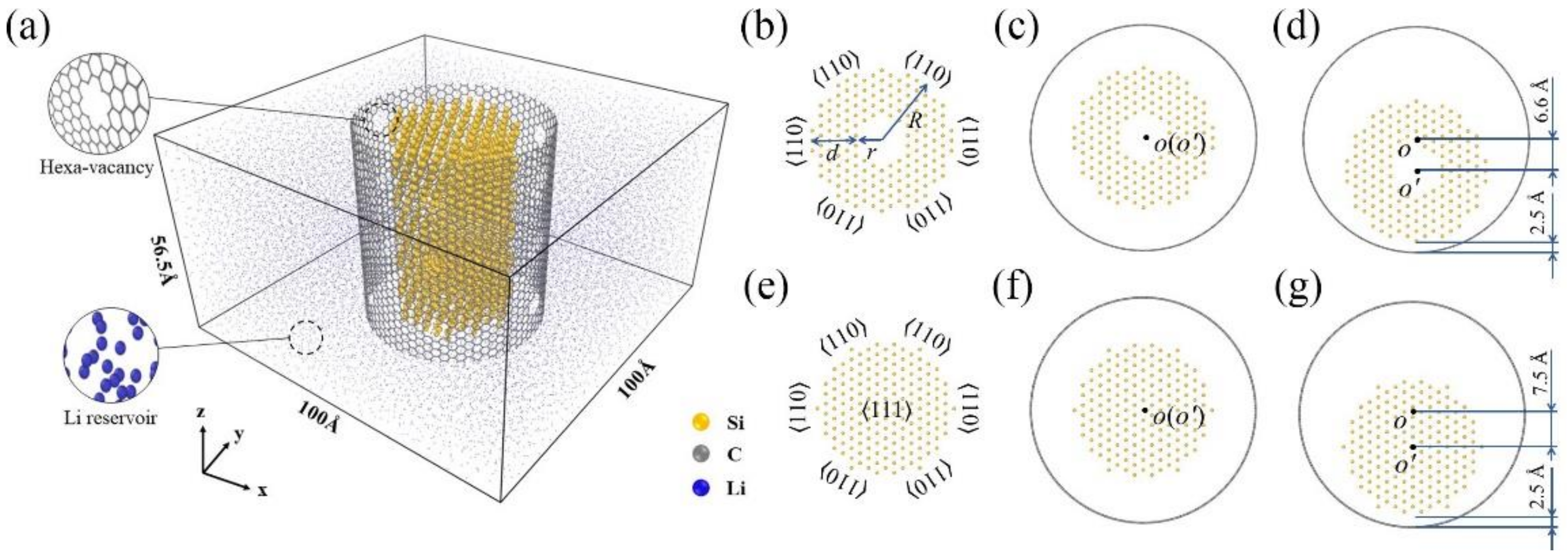

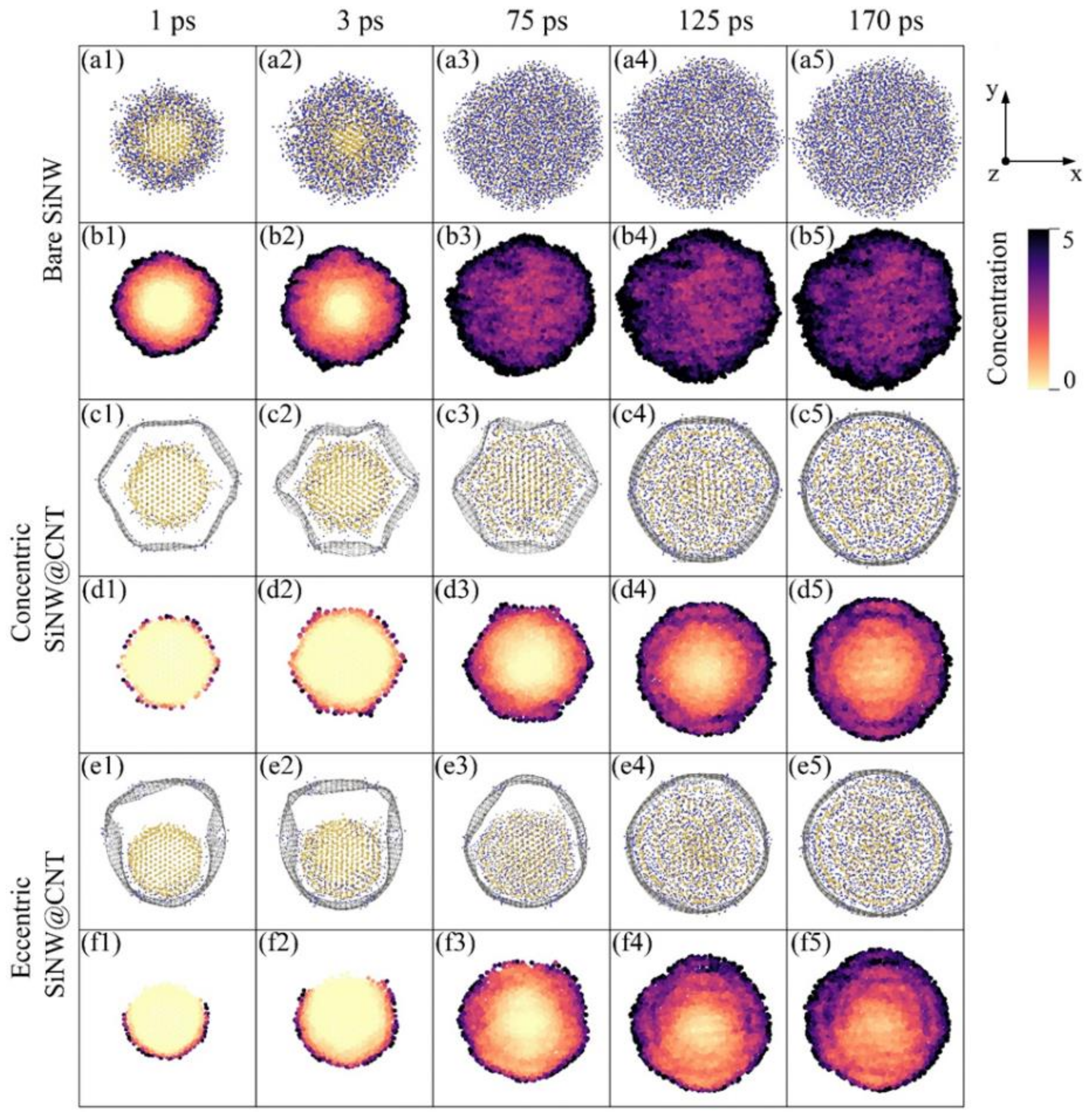

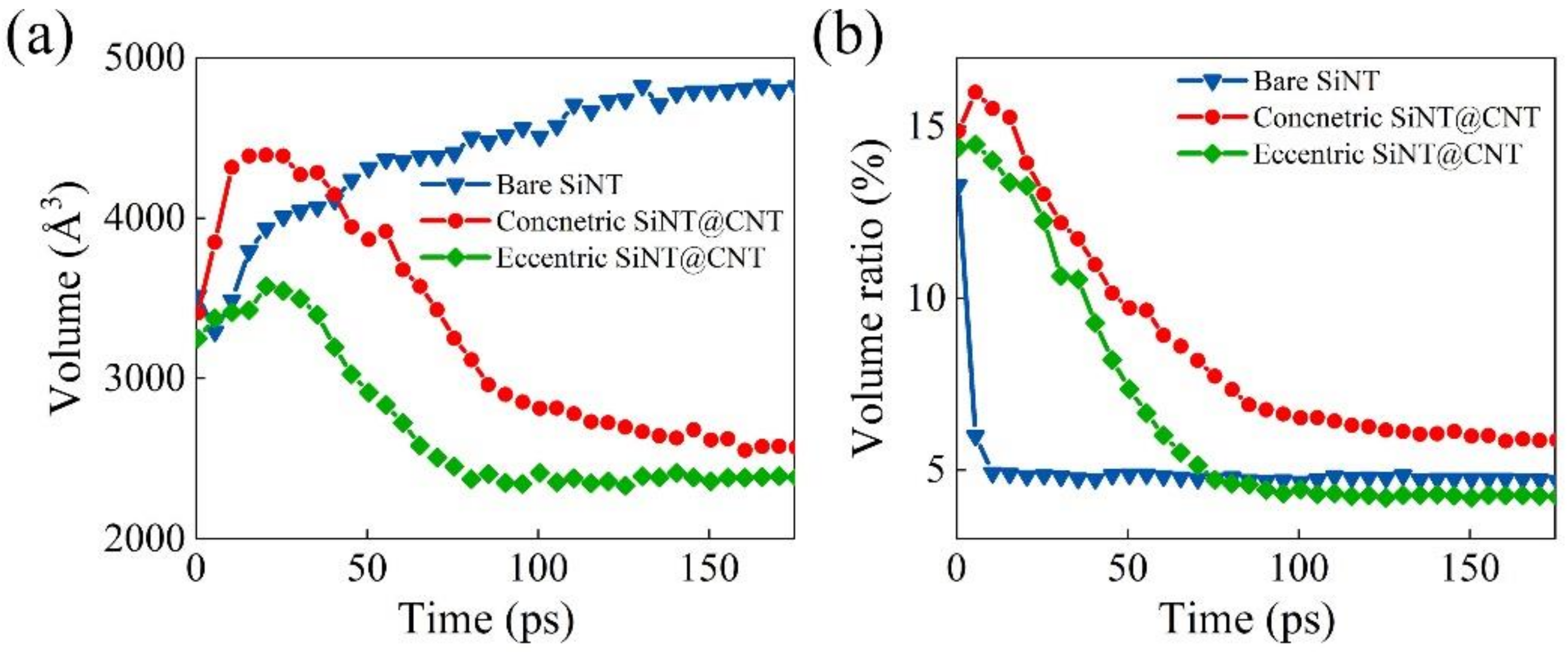
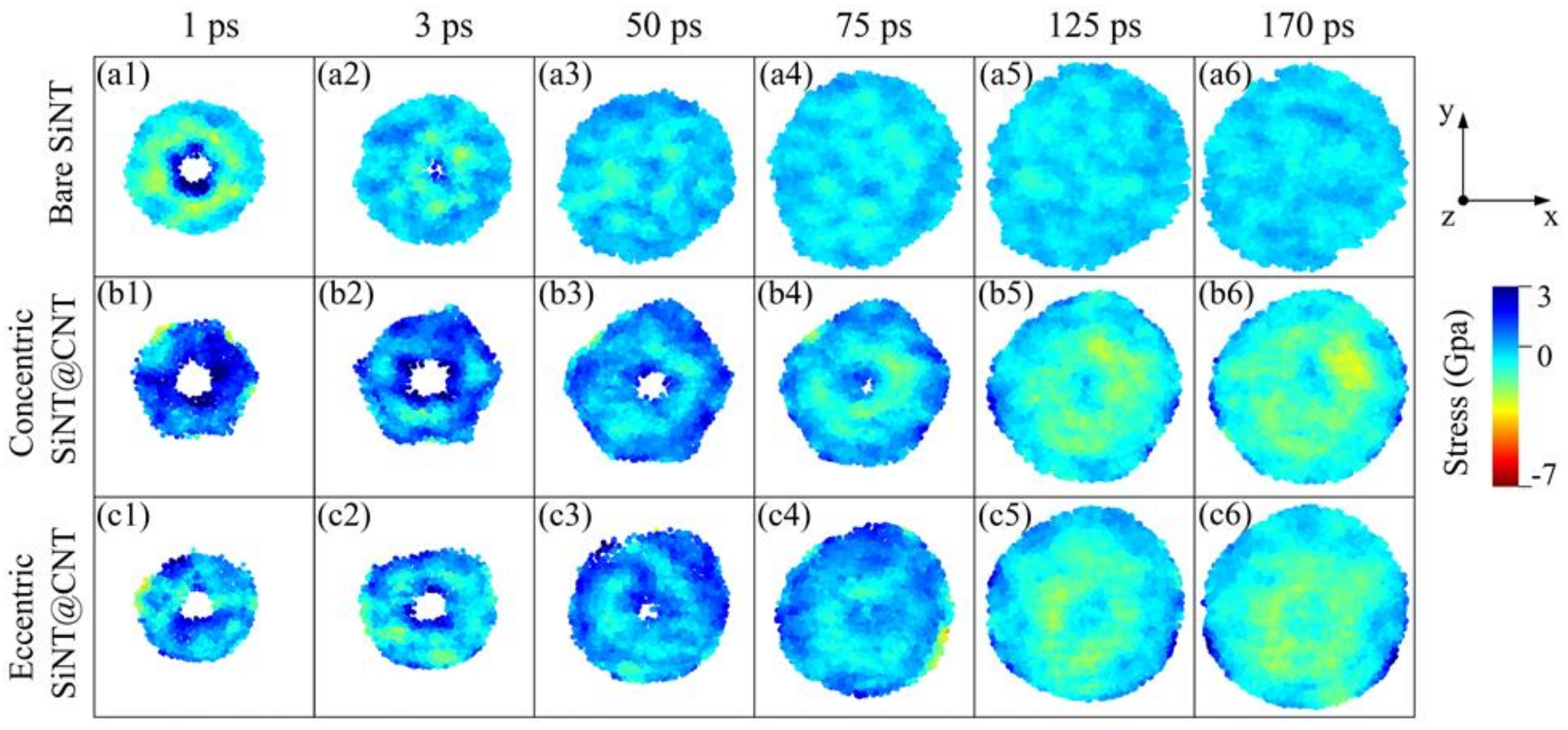

Publisher’s Note: MDPI stays neutral with regard to jurisdictional claims in published maps and institutional affiliations. |
© 2021 by the authors. Licensee MDPI, Basel, Switzerland. This article is an open access article distributed under the terms and conditions of the Creative Commons Attribution (CC BY) license (http://creativecommons.org/licenses/by/4.0/).
Share and Cite
Feng, C.; Liu, S.; Li, J.; Li, M.; Cheng, S.; Chen, C.; Shi, T.; Tang, Z. Molecular Understanding of Electrochemical–Mechanical Responses in Carbon-Coated Silicon Nanotubes during Lithiation. Nanomaterials 2021, 11, 564. https://doi.org/10.3390/nano11030564
Feng C, Liu S, Li J, Li M, Cheng S, Chen C, Shi T, Tang Z. Molecular Understanding of Electrochemical–Mechanical Responses in Carbon-Coated Silicon Nanotubes during Lithiation. Nanomaterials. 2021; 11(3):564. https://doi.org/10.3390/nano11030564
Chicago/Turabian StyleFeng, Chen, Shiyuan Liu, Junjie Li, Maoyuan Li, Siyi Cheng, Chen Chen, Tielin Shi, and Zirong Tang. 2021. "Molecular Understanding of Electrochemical–Mechanical Responses in Carbon-Coated Silicon Nanotubes during Lithiation" Nanomaterials 11, no. 3: 564. https://doi.org/10.3390/nano11030564
APA StyleFeng, C., Liu, S., Li, J., Li, M., Cheng, S., Chen, C., Shi, T., & Tang, Z. (2021). Molecular Understanding of Electrochemical–Mechanical Responses in Carbon-Coated Silicon Nanotubes during Lithiation. Nanomaterials, 11(3), 564. https://doi.org/10.3390/nano11030564








